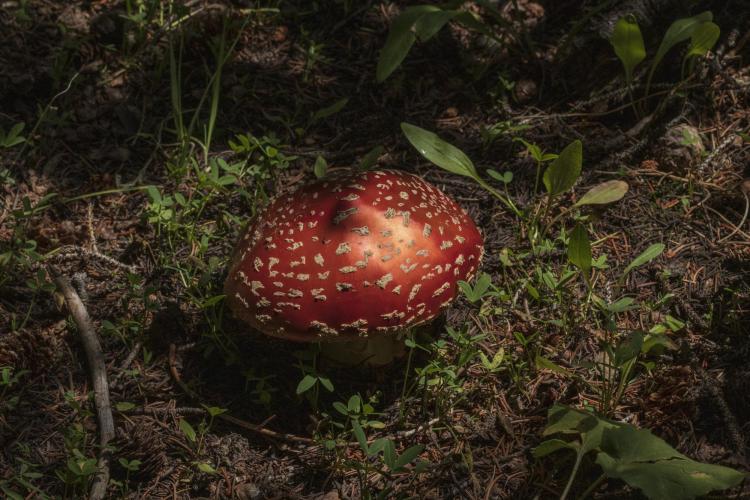Fly Agaric and related death cap mushrooms synthesize dangerous chemicals
Amanita species can be described as edible, inedible, poisonous, deadly poisonous, and psychoactive
A week of rain capped by a deluge from slow-moving thunderstorms brought seven mudslides into the Middle Fork Valley in the San Juan Mountains. The same rains triggered the appearance of many species of mushrooms, particularly fly agaric, Amanita muscaria. Amanita mushrooms evolved in the area of Siberia and Beringia more than 3 million years ago.

Both Fly Agaric and Death Cap mushrooms have yellow forms. Photo by Jeff Mitton.
Fly agaric is native to northern temperate and boreal forests around the world and is now a successful invader in the southern hemisphere in Australia, New Zealand, South Africa and South America.
Fly agaric is the icon of mushrooms, the best known around the world, for it has been used for a variety of purposes for thousands of years. Rock art in Algeria dated to 3,500 BC depicts priests using fly agaric. As early as 1,256 AD, before screens had been invented, homes, taverns and markets swarmed with flies. A chunk of fly agaric in a saucer of milk attracted and killed flies.
Almost all of the approximately 500 species of fungi in the genus Amanita are ectomycorrhizal, meaning that they obligately form symbiotic relationships with the roots of both deciduous and coniferous trees. The fungi receive nutrients across mycorrhizal bridges and in return they provide nutrients gathered from the soil.

At the top of the page: A strand of mushrooms showing the variability in the field. Above: More variability of a strand of mushrooms, young and old. Photos by Jeff Mitton.
I found an area beside the Western Fork of the Cimarron River that had numerous fly agarics, some growing as singletons and others growing in strands, probably following the roots of spruces and firs. I certainly saw some with the classic colors of fly agaric -- a deep red cap speckled with white scales or warts, but several others were deep orange, almost bronze, and at lower elevations I found several with yellow caps. I have since learned that fly agaric can be several shades of red, reddish orange, distinctly yellow or completely white.

Amanita Muscaria single red is the most easilt recognized morph. Photo by Jeff Mitton.
Genetic studies into fly agaric from North America, Mexico, Europe and Russia found that this was not a single species, but a minimum of eight. Furthermore, some of the species were found growing in the same geographic area. For example, three species were found in Alaska, but one of them was separated from the others because it grew only in the alpine. Three species were found growing only on Santa Cruz Island, near Santa Barbara. Preliminary observations suggest that the different species are adapted to different environments and host species. Currently, the genus Amanita is composed of about 500 species, but geneticists predict that once geneticists have examined other Amanita species the total number will rise to 1,000.
For thousands of years shamans and priests used fly agaric to enter trances, experience visions and gain divine guidance."
Amanita species can be described as edible, inedible, poisonous, deadly poisonous, and psychoactive. Fly agaric is listed as both poisonous and psychoactive. It synthesizes ibotenic acid and muscimol, which are both poisonous and psychoactive. Symptoms of poisoning include nausea, vomiting, dizziness, hallucinations, involuntary movements, delirium and seizures.
For thousands of years shamans and priests used fly agaric to enter trances, experience visions and gain divine guidance. Viking Beserker Warriors used it before combat to initiate a state of rage and indifference to pain. Writers have used it to enhance focus and gain inspiration. Many others used it to experience hallucinations. But extreme caution is warranted, for even experts have difficulty and differences of opinion when it comes to identifying species. I thought I could identify Amanita muscaria but my experiences with multiple shapes, ages, sizes and colors of fly agaric in the San Juan Mountains was confusing and the recent revelation that fly agaric is a minimum of eight species compounded my uncertainty. Genetic data are needed for identification, for the penalty for error is grave. Do all eight cryptic species have the same chemicals? No one can say for sure.
The deadly poisonous Amanita species synthesize amanitin, a cyclic protein that destroys the liver and kidneys. Two deadly species are in western North America. The destroying angel, Amanita bisporigera, has been reported in Colorado nine times. Death cap, Amanita phalloides, is the most notorious Amanita, for it kills more than any other. It is native to Europe but was accidentally introduced to California around 1938, probably on the roots of cork oaks imported to provide corks for the wine industry. It is now widespread in California and is evolving to utilize more species of host trees. I suspect it will soon colonize Colorado. The color of its cap varies, but like fly agaric, some have yellow caps. Amanitin produces symptoms within nine hours of consumption, but these symptoms diminish and disappear in one to two days. Unfortunately, symptoms return with a vengeance in a week. If medical intervention has not been secured within the first three days after consumption, nothing but a liver transplant can avoid weeks of agony ending in death.

